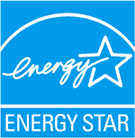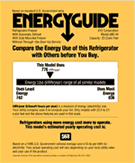Windows/Window Treatments
In This Guide
Get Rebates,
Incentives & Services
Introduction
Windows bring light, warmth and beauty into buildings and give a feeling of openness and space to living areas. They can also be major sources of heat loss in the winter and heat gain in the summer: As much as 30% of the heating and cooling of a typical home is lost through its windows. In a single year (1990), the energy used to offset unwanted heat losses and gains through windows in residential and commercial buildings cost the United States $20 billion (one-fourth of all the energy used for space heating and cooling). However, when properly selected and installed, windows can help minimize a home's heating and cooling costs.
Technology Options
Three major factors contribute to the overall energy characteristics of today's windows: how they are framed, the type of glazing that is used, and the type of fill in the air space. Unless properly sealed, window frames can be a major source of air infiltration, literally bleeding the warmth and coolness out of your home. The glazing of a window is responsible for the majority of heat loss and solar gain. There are ways in which these factors can be modified in order to increase energy and money savings.
Framing
Frames may be made out of wood, wood clad, aluminum, aluminum with thermal break, hybrid/composite, fiberglass, insulated vinyl or vinyl. The frame type used will influence the heat flow through the window, which is generally measured by the windows U-factor. The lower the U-factor, the better the job the window does in reducing the heat flow through the window. Since the frame represents 10 to 30% of the total window area, the frame material can significantly affect the overall window performance. Aluminum windows tend to have higher U-factors given their high thermal conductance. Wood, hybrid/composite, fiberglass and vinyl are generally the best choices in areas where heating and cooling needs are extreme.
Glazing
Glazing refers to the actual glass and coating on the window pane. In the past, single panes of clear glass were the norm, but with many advances, window glazing can provide high-performance, attractive windows. There are many types of glazing systems that control heat gain and loss through windows. These include double- and triple-pane windows with such coatings as low-emissivity (low-e), spectrally selective, heat-absorbing (tinted), or reflective; gas-filled windows; and windows incorporating combinations of these options.
-
Low-E Glazing: Low-e glazings have special coatings that reduce heat transfer through windows and thus improve the window's U-factor. The coatings are thin, almost-invisible metal, metal oxide or semiconductor films that are placed directly on one or more surfaces of glass or on plastic films between two or more panes. The coatings typically face air spaces within windows and reduce heat flow between the panes of glass. Windows manufactured with low-e films typically cost about 10 to 15% more than regular windows, but they reduce energy loss by as much as 30 to 50%.
Spectrally Selective Coating: Spectrally selective coatings are designed to allow only specified ranges of radiation from the sun through the glass, reducing heat gained from sun shining into the home. These coatings filter out from 40 to 70% of the heat normally transmitted through clear glass, while allowing the full amount of light to be transmitted. Spectrally selective coatings can be applied on various types of tinted glass to produce "customized" glazing systems capable of providing the desired level of solar gain for the climate region. Computer simulations have shown that advanced glazings with spectrally selective coatings can reduce the space cooling requirements of new homes in hot climates by more than 40%.
Heat-Absorbing/Tinted Glazings: Another technology uses heat-absorbing glazings with tinted coatings to absorb solar heat gain. Some heat continues to pass through tinted windows by conduction and reradiation, but inner layers of clear glass or spectrally selective coatings can be applied with tinted glass to further reduce this heat transfer. Heat-absorbing glass reflects only a small percentage of light and therefore does not have the mirror-like appearance of reflective glass.
Reflective Coatings: Like tinted coatings, reflective coatings greatly reduce the transmission of daylight through clear glass, thereby reducing the heat gained indoors from the sun. Although they typically block more light than heat, reflective coatings, when applied to tinted or clear glass, can also slow the transmission of heat. Reflective glazings are commonly applied in hot climates in which solar control is critical; however, the benefit of reduced cooling energy demand may be offset by the need for additional electrical lighting because less sunlight is entering the home.
Gas-filled Windows: Gas filled windows reduce the heat conductance of the air space between multiple panes by replacing that air with either argon or krypton gas. Originally, the space between panes was filled with air before it was sealed. In a sealed insulating glass unit, air currents between the two panes of glazing carry heat to the top of the unit and settle into cold pools at the bottom. Filling the space with a less conductive, more viscous or slow-moving gas minimizes the convection currents within the space, conduction through the gas is reduced, and the overall transfer of heat between the inside and outside is reduced. Argon is inexpensive, nontoxic, nonreactive, clear and odorless.
Energy Ratings
'The National Fenestration Rating Council', (NFRC) is the leading trade association for residential windows energy ratings. The NFRC label indicates a windows U-value, SHGC, air leakage and visible transmission. The U-value is the conductance of heat. If a window's U-value is low, it will lose less heat than one with a higher U-value. Solar heat gain coefficient (SHGC) is the fraction of solar energy transmitted through the window. The lower the SHGC, the less heat the home will gain from the sun, so a low SHGC is a key criterion for hot and sunny climates.
Efficiency Benefits
The amount of energy and money you save with high efficiency windows will depend on the building's location, orientation, total window area and the type of glazing on the windows.
The following table summarizes total annual heating and cooling costs for an existing 2,000-sq.-ft. home with windows (15% glazing) equally distributed on all sides of the house and typical shading. It is assumed that existing homes have less insulation than new homes. Costs are based on heating and cooling typical for the region; electric and gas costs are obtained from 'U.S. Department of Energy (DOE) - Energy Information Administration (EIA).' Compared are a base conventional window (single glazed, clear, with aluminum frame) and two 'ENERGY STAR', double-glazed low-e windows (one with a high SHGC and one with low SHGC).
| Single-glazed, clear, Aluminum Frame U=1.25, SHGC=0.76 | ENERGY STAR Double-glazed with moderate solar gain low-e, wood or vinyl frame U=0.33, SHGC=0.40 |
ENERGY STAR Double-glazed with low solar gain low-e, wood frame U=0.32, SHGC=0.30 |
|
| North Coast | $827 | $660 | $719 |
| South Coast | $264 | $185 | $195 |
| Inland | $814 | $738 | $733 |
| Desert | $1,066 | $793 | $785 |
| Mountain | $1,980 | $1,379 | $1,285 |
Manufacturers
Acadia Windows and Doors, CertainTeed, Serious Windows and Owens Corning are some of the manufacturers of ENERGY STAR qualified windows. For a complete list, visit the ENERGY STAR website.
Purchasing Tips
Before purchasing energy-efficient windows, it is very important that you customize your choice based on your particular application and location.
|
||
Emerging Technology
There are many promising high-tech glazing solutions on the horizon. Already on the market are "super windows" with triple glazing, double low-e films and mixtures of gasses in their insulating layers. In addition, there are “smart windows” in development that respond to changing conditions. This is achieved through "switchable glazings" which change their properties in response to an electrical charge or an environmental signal, such as a change in light levels. Two such "switchable glazings" that have energy saving applications are electrochromic and thermochromic.
Electrochromic Glazing
Electrochromic glazing can go from clear to dark-tinted and any level in between through the application of an electrical field. These can be used to reduce glare or to ward off increases in solar heat. To make an electrochromic window, a thin, multi-layer assembly is sandwiched between traditional pieces of glass. The two outside layers of the assembly are transparent electronic conductors.
Next is a counter-electrode layer and an electrochromic layer, with an ion conductor layer in between. When a low voltage is applied across the conductors, ions moving from the counter-electrode to the electrochromic layer cause the assembly to change color. Reversing the voltage moves ions from the electrochromic layer back to the counter-electrode layer, restoring the device to its previous clear state. The glass may be programmed to absorb only part of the light spectrum, such as solar infrared.
Early research indicates that electrochromic glazing can save substantial amounts of energy in buildings, and may eventually replace traditional solar control technology, such as tints, reflective films and shading devices.
Thermochromic Windows
In response to changes in ambient temperature, thermochromic glazings go from being clear to diffused. "Cloud Gel," a product now on the market, is a thin plastic film that can be incorporated into almost any window assembly. The response temperatures of "Cloud Gel" can be adjusted depending on need and location. The glazings can also turn white and reflective, reducing the transmission of solar heat, which can reduce air conditioning costs significantly when it is hot outside. Because one can no longer see through the window once it loses its transparency, this glazing is probably best suited for skylights.











